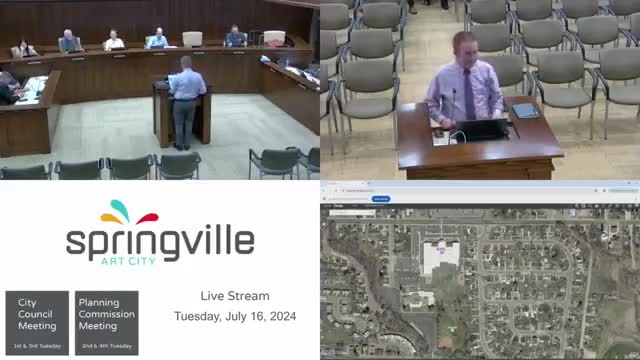Springville Council amends townhome height regulations to streamline development process
August 17, 2024 | Springville City Council, Springville, Utah County, Utah
This article was created by AI summarizing key points discussed. AI makes mistakes, so for full details and context, please refer to the video of the full meeting. Please report any errors so we can fix them. Report an error »

In the heart of Springville, city council members gathered under the warm glow of the meeting room lights, ready to tackle pressing issues that shape the community's landscape. Among the discussions was a significant amendment concerning the Main Street South Gateway zone, aimed at easing the design and construction of townhomes in the area.
The council reviewed a proposal to eliminate the minimum clear floor-to-ceiling height requirement for townhomes, a regulation that had complicated development efforts. Josh, a city planner, explained that the existing height restrictions were primarily designed for Main Street buildings, which often feature tall first floors to maintain a historic aesthetic. However, these requirements had inadvertently hindered the design flexibility needed for townhomes, leading to awkward proportions and increased construction challenges.
The proposed change would establish a universal minimum first-floor elevation of 18 inches above the sidewalk, a height deemed essential for creating a comfortable transition from public to private spaces. This adjustment aims to enhance the visual appeal and usability of townhome porches, making them feel more inviting and less imposing. The planning commission had unanimously recommended this amendment, recognizing its potential to improve the overall design quality of new developments.
Council members engaged in a thoughtful dialogue about the implications of this change. Mindy raised concerns about creating too many specific regulations for different zones, questioning whether a more unified approach might be beneficial in the long run. Josh acknowledged the need for a comprehensive zoning overhaul to address such inconsistencies, but emphasized that this immediate amendment was necessary to alleviate current design challenges.
As the discussion progressed, the council also addressed the importance of accessibility in urban design. Mindy pointed out that the proposed height might pose challenges for individuals with mobility issues, prompting a commitment to evaluate accessibility standards in future zoning revisions.
Ultimately, the council voted in favor of the ordinance to amend the height requirements, signaling a step forward in facilitating townhome development in Springville. This decision not only reflects the city's responsiveness to development pressures but also highlights a broader commitment to creating a welcoming and functional urban environment.
In addition to the height amendment, the council approved a new checklist for residential and commercial subdivision applications, streamlining the process for developers and ensuring consistency in requirements. This move is expected to enhance efficiency and clarity in the application process, making it easier for developers to navigate the city's regulations.
As the meeting concluded, the council's decisions echoed a commitment to balancing development needs with community aesthetics and accessibility, paving the way for a more vibrant and inclusive Springville.
The council reviewed a proposal to eliminate the minimum clear floor-to-ceiling height requirement for townhomes, a regulation that had complicated development efforts. Josh, a city planner, explained that the existing height restrictions were primarily designed for Main Street buildings, which often feature tall first floors to maintain a historic aesthetic. However, these requirements had inadvertently hindered the design flexibility needed for townhomes, leading to awkward proportions and increased construction challenges.
The proposed change would establish a universal minimum first-floor elevation of 18 inches above the sidewalk, a height deemed essential for creating a comfortable transition from public to private spaces. This adjustment aims to enhance the visual appeal and usability of townhome porches, making them feel more inviting and less imposing. The planning commission had unanimously recommended this amendment, recognizing its potential to improve the overall design quality of new developments.
Council members engaged in a thoughtful dialogue about the implications of this change. Mindy raised concerns about creating too many specific regulations for different zones, questioning whether a more unified approach might be beneficial in the long run. Josh acknowledged the need for a comprehensive zoning overhaul to address such inconsistencies, but emphasized that this immediate amendment was necessary to alleviate current design challenges.
As the discussion progressed, the council also addressed the importance of accessibility in urban design. Mindy pointed out that the proposed height might pose challenges for individuals with mobility issues, prompting a commitment to evaluate accessibility standards in future zoning revisions.
Ultimately, the council voted in favor of the ordinance to amend the height requirements, signaling a step forward in facilitating townhome development in Springville. This decision not only reflects the city's responsiveness to development pressures but also highlights a broader commitment to creating a welcoming and functional urban environment.
In addition to the height amendment, the council approved a new checklist for residential and commercial subdivision applications, streamlining the process for developers and ensuring consistency in requirements. This move is expected to enhance efficiency and clarity in the application process, making it easier for developers to navigate the city's regulations.
As the meeting concluded, the council's decisions echoed a commitment to balancing development needs with community aesthetics and accessibility, paving the way for a more vibrant and inclusive Springville.
View full meeting
This article is based on a recent meeting—watch the full video and explore the complete transcript for deeper insights into the discussion.
View full meeting

